Kansas Geological Survey, Current Research in Earth Sciences, Bulletin 252, part 1
Prev Page--Geologic Setting || Next Page--Depositional Environments
Kansas Geological Survey, Current Research in Earth Sciences, Bulletin 252, part 1
Prev Page--Geologic Setting ||
Next Page--Depositional Environments
![]()
The main facies identified in cores from the Schaben field include 1) Mudstone/Wackestone (MW); 2) Sponge Spicule-Rich Wackestone-Packstone (SWP); 3) Echinoderm-Rich Wackestone-Packstone-Grainstone (EWPG); and 4) Dolomitic Siltstone & Shale Facies. Other features identified in cores include: 1) Silica Cementation & Replacement; 2) Silica Replaced Evaporites; 3) Brecciation & Fracturing; and 4) Calcite Cementation & Replacement. The facies and other features are described in tables 1 and 2, and shown in figs. 4-10. Evidence for early silicification, evaporites, and dolomitization is included in table 3 as these are particularly important for depositional environment interpretations.
Table 1--Depositional facies.
| Facies Name | Grain Types | Sedimentary Features | Other Characteristics |
|---|---|---|---|
| Mudstone/Wackestone (MW) | Identifiable grains rare. Sponge spicules (mostly monaxon) and their molds are most identifiable grain type; echinoderm, bryozoan, brachiopod, gastropods, peloids, glauconite locally present. Rare concentrations of very fine grained (∼100 µm) detrital quartz grains. Pyrite occurs as accessory mineral. | Typically laminated or wavy to wispy laminated (fig. 4A). Locally massive. Local mottled texture from burrowing results in local concentrations of sponge spicules in pockets on microscopic scale. Local dark blebs and clotted areas likely are from organic matter and may indicate microbial structures. Local soft sediment. Local fenestral fabric. | Typically tight or has moldic, intercrystalline, and minor vuggy porosity locally developed (6-22%, Byrnes and Franseen, 2000). Mottling texture and lamination locally results in variable tight and porous areas at a thin- section scale. Dolomite occurs as very finely crystalline to micrite size (∼20 µm to <100 µm), subhedral to anhedral crystals; euhedral crystals locally. Commonly contains silica- replaced evaporites. Silica locally replaces matrix and grains. |
| Sponge Spicule-Rich Wackestone-Packstone (SWP) | Sponge spicules (mostly monaxon) and their molds are predominant grains commonly exclusive (fig. 4B, C). Sponge spicules are originally siliceous (central axial canal locally identifiable; fig. 4B). Rare identifiable triaxon spicules. Echinoderm, bryozoan, gastropod, peloids, and glauconite grains occur more rarely. Pyrite is locally an abundant accessory mineral. | Mottled, wispy horizontal laminated, and wavy horizontal laminated and textures are common; sponge spicules locally concentrated in layers. Laminations imparted locally by green/gray shale/siltstone and horsetail stylolites. Mottled textures from burrowing result in local concentrations of grains in pockets on microscopic scale. | Moldic (fig. 4C), intercrystalline, and minor vuggy porosity ranges from 18 to 25% (Byrnes and Franseen, 2000). Fenestral fabric occurs locally. Mottling texture and concentration of grains in layers locally results in variable tight and porous areas. Dolomite occurs as very finely crystalline to micrite size (∼20 µm to <100 µm), subhedral to anhedral crystals. Commonly contains silica-replaced evaporites. Silica locally replaces matrix and grains (fig. 4B, D). |
| Echinoderm-Rich Wackestone-Packstone-Grainstone (EWPG) | Echinoderm fragments dominant; abundant sponge spicules, bryozoan fragments, brachiopods, solitary coral fragments, gastropods, ostracods, peloids, calcispheres, skeletal debris; minor complex grains and oncolites. Skeletal fragments generally disarticulated but not highly abraded or micritized. Very fine to fine-grained detrital quartz grains occur locally. Where replaced by silica, the grain textures may be preserved or are molds filled with chert, silica or calcite cement (fig. 5A). Where dolomitic, skeletal grains typically preserved as molds (fig. 5B). | Where dolomitic, typically has a wispy laminated or mottled texture; locally it has a massive texture. Locally, interbedded skeletal rich layers (more porous) and skeletal poor layers (tighter) result in an alternating porous and tight layering within this facies. Horizontal laminations and low-angle cross laminations locally. Local sorting of grains into fine-grained layers and coarser-grained layers; local normal grading of grains. Typically not much evidence for over compaction or early compaction. Grains locally show compromise boundaries, overly close packing, grain breakage and flat, horizontal alignment of skeletal fragments, Only minor occurrences of original calcite syntaxial overgrowths. Grainstones locally have isopachous chalcedony cement that coats grains and lines primary pores (fig. 5C). Some original molds, fenestrae, and vugs contain a floored (geopetal) internal sediment that was silicified with remainder of pore space filled with silica cement (fig. 5C). | Commonly partially or pervasively replaced with porcelaneous (tight) or, locally, tripolitic (porous) chert/megaquartz. Abundant vuggy and microcrystalline porosity in tripolitic chert areas and both tripolitic and porcelaneous chert typically contains micro- and mega- fracture porosity. Vugs locally developed within chert areas and partially or fully filled with silica cement. Fenestral pores either partially or fully filled with silica cement occur locally (fig. 5D). Some pores contain a silicified internal marine sediment and a later pore filling, or partially filling silica cement. Where dolomitic, porosity in this facies can exceed 22% (Byrnes and Franseen, 2000). Common porosity types include moldic, moldic reduced, intercrystalline, and vugs. Dolomite typically very finely crystalline (∼50 µm or less) but locally exceeds 150 µm. Crystals are typically subhedral to euhedral. Some crystals zoned with a clear to turbid (locally calcian) center and clear dolomite rim. Some dedolomite. |
| Dolomitic Siltstones & Shale | Composed predominantly of very fine grained sand (∼100 µm) to silt-sized (<50 µm) quartz grains and clays; sand- to pebble-size grains occur locally (fig. 6). | Wavy to wispy laminated and locally displays low-angle lamination. Shale locally occurs as wispy layers in dolomitic mudstone or wackestone facies. | Occurs as interbedded layers or as fracture fill and breccia matrix containing clasts of carbonate facies and replacive silica (fig. 3). |
Table 2--Other core features.
| Core Features | Characteristics |
|---|---|
| Silica | Replacement silica and silica cements abundant throughout all three cores (fig. 3). Convoluted nodular, anastamozing bedded and bedded replacements (terminology of Nolte and Benson, 1998) are characteristic in EWPG facies (fig. 7). Disseminated silica, characterized by "ragged" boundaries with unsilicified strata of the same facies, is most common in the MW and SWP facies (fig. 7). Silica replacement occurs either as pervasive or partial replacement of original facies, textures or grains. Silica typically white to light gray in hand sample with a porcelaneous (tight) or more rarely a chalky porous (tripolitic) texture. Much of the chert replacement appears to follow original burrows or bedding planes. Silicified areas commonly exhibit a fracture and brecciated texture with variable micro-and macro-fracture porosity.
Silica occurs as microquartz, megaquartz, chalcedony (both length-fast and length-slow), and zebraic chalcedony. Some microspherules (approximately 25-40 µm diameter) occur and may represent original cristobalite lepispheres. Silica replacement and cementation appear to have occurred in stages with early microquartz and chalcedony replacement of facies and grains, isopachous brown chalcedony cement lining pores and megaquartz as a later stage replacement or pore-filling cement (fig. 5A, C). Ghosts of micron-sized microstructural features in some silicified grains that were originally carbonate, such as echinoderms, indicate that silica precipitation and carbonate dissolution occurred simultaneously along thin solution films (fig. 5A; Maliva and Siever, 1989). Void-filling silica indicates a more rapid volumetric calcite dissolution rate than the volumetric silica precipitation rate (fig. 5C). Silica in the form of microquartz or chalcedony locally preferentially replaces spicules (fig. 4B) or replaces the matrix surrounding the spicules and leaves the spicules as molds (fig. 4D). |
| Silica-Replaced Evaporites | Silica-replaced evaporite textures include individual crystals, initial nodule development, complete nodule development, laterally coalesced nodules forming horizontal layers, some of which are composed of coalesced vertically elongate nodules (fig. 8), and local chicken-wire structure (fig. 9A). Individual nodules are generally <0.5 to 5 cm in size. Nodules and crystals preserve a bladed, radiating bladed, and twinned crystal morphology (fig. 9B), indicating replacement of anhydrite or gypsum. Individual bladed crystals, many with blunt ends, are typically between 100 µm-300 µm in length (20-60 µm width) with some blades over 500 µm in length (fig. 9B, C). Some megaquartz crystals in replaced evaporites contain abundant inclusions of evaporite minerals (anhydrite).
Some preserved fabrics of pseudomorphed evaporites show crystal fabric evolution characteristic of different modes of nodular anhydrite growth as depicted by Shearman and Fuller (1969). Crystals show a d-decussate and sub-parallel arrangement of laths within the more central portion of the nodules, and the laths become "bent" and sub-parallel to the periphery of the nodule at the contact with the host sediment (fig. 9C). |
| Brecciation & Fracturing | Macro- and micro-scale brecciation and fracturing are ubiquitous throughout the three cores (fig. 10) resulting in fracture and mosaic breccias. Textures range from little to no rotation on clasts to matrix-supported and clast-supported chaotic breccias that represent mixtures of autochthonous and allochthonous materials resedimented by gravitationally driven processes.
Fracture fill and breccia matrix includes shale, subangular to rounded, silt- to coarse-grained size detrital quartz, chert, megaquartz, chalcedony grains, carbonate micrite, carbonate grains, and skeletal grains. Clasts (ranging from rounded to angular) include chert/chalcedony/megaquartz fragments, clasts of original carbonate facies, replacive poikilotopic calcite clasts, coarse calcite cement fragments, and rubble of red and greenish limy clay. Porosity associated with fracturing and brecciation is quite variable, ranging from tight to very porous. Interparticle, intercrystalline, vuggy, and fracture porosity are common porosity types in breccia matrix. |
| Calcite Cementation & Replacement | Several different stages of calcite cementation and replacement occur. One event is associated with subaerial exposure (SB1 surface) (figs. 3, 10, 12) and results in locally extensive calcite replacement and cementation of DS1 strata. A later stage of calcite cementation and replacement is associated with post-Mississippian subaerial exposure that affects facies in the upper portions of cores (fig. 3). |
Figure 4A--Mudstone/Wackestone (MW) Facies. Wispy lamination imparted by clay and horsetail stylolites. This facies is typically tight.

Figure 4B--Sponge Spicule-rich Wackestone/Packstone (SWP) Facies. In this sample the siliceous sponge spicules (note central axial canals) are preserved by microcrystalline quartz and chalcedony. Much of the matrix is silicified and only a minor amount of intercrystalline porosity is present.

Figure 4C--More typical preservation of SWP Facies with abundant sponge spicule molds (blue epoxy areas) and intercrystalline porosity in dolomite matrix. This is the main reservoir facies in Schaben field.

Figure 4D--Sponge spicules have been dissolved leaving molds (dark-blue round/oblong areas) and the surrounding matrix has been mostly replaced by silica (light areas). Much of the matrix in the upper right corner remains dolomitic.
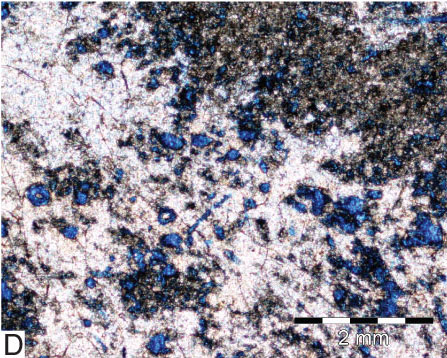
Figure 5A--Silicified Echinoderm-rich Wackestone/Packstone/Grainstone (EWPG) Facies. Packstone-grainstone texture has largely been preserved. Echinoderm fragments with textures preserved or molds filled by silica cement predominate. Abundant fragments of other skeletal material occur, including sponge spicules, which also are replaced by silica or have molds filled with silica cement.

Figure 5B--Echinoderm-rich Wackestone/Packstone/Grainstone (EWPG) Facies. Echinoderm fragments and other skeletal fragments, including sponge spicules, have been dissolved leaving abundant moldic porosity (blue areas) in relatively tight dolomitic matrix.

Figure 5C--Silicified Echinoderm-rich Wackestone/Packstone/Grainstone (EWPG) Facies. Echinoderm fragments generally lack evidence of syntaxial overgrowths. Typically, primary pores are lined by brown isopachous chalcedony cement (arrows). Primary pores, or molds of echinoderms, are filled by later quartz cement (Q).
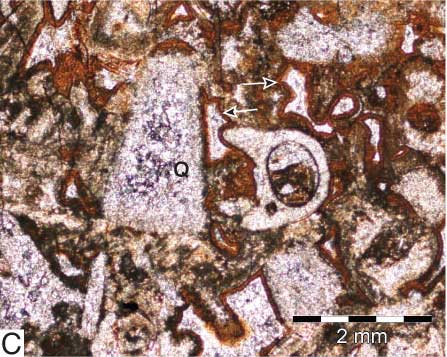
Figure 5D--Silicified Echinoderm-rich Wackestone/Packstone/Grainstone (EWPG) Facies. This sample contains fenestral-type pores (arrows) filled by quartz cement.
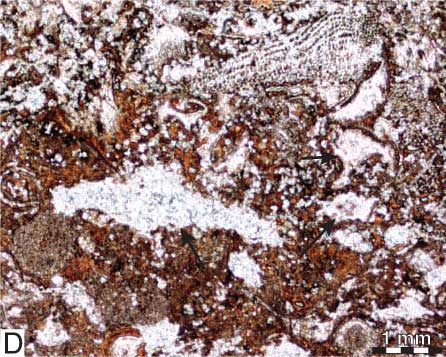
Figure 6--Shale/siltstone/sandstone layers are locally present, typically interbedded with SWP or MW facies. This facies occurs as interbedded layers associated with deposition during Osagean time and as post-depositional fill associated with SB1 and the pre-Pennsylvanian unconformity. This sample contains mostly subround to subangular detrital quartz grains with minor clay. Scale 1 mm. Crossed nicols.

Figure 7--Different types of silica replacement. Core photo on the left is of EWPG Facies, which is characterized by convolute nodular, anastamozing bedded and bedded replacement chert (following terminology of Nolte and Benson, 1998). White and whitish-gray areas are chert and light-tan to light-gray areas are carbonate. Core photo on the right is of SWP Facies which is characterized by disseminated silica and "ragged" boundaries with unsilicified strata of the same facies. Whitish-gray areas are silica and darker-brown areas are dolomite.

Figure 8--Core photo. Base of core consists of SWP Facies containing abundant silica-replaced evaporite nodules (white-gray to gray colored areas). Several evaporite nodule morphologies can be seen in this interval; vertically elongate crystals coalescing to form a layer (near base), individual round to oblong nodules, and coalesced nodules. Several coalesced nodules are truncated, with the truncation surface overlain by chertified echinoderm-rich grainstone containing silica cement-filled fenestral and vuggy pores.

Figure 9--Silica-replaced evaporite textures. A) This sample contains evaporite nodules in dolomitic SWP Facies forming "chicken-wire texture." The base of the sample contains elongate fenestral-type pores.
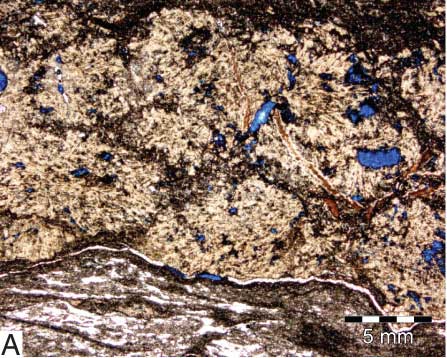
Figure 9--Silica-replaced evaporite textures. B) Silica-replaced bladed and radiating bladed crystal pseudomorph textures of original evaporite (anhydrite, gypsum) minerals in SWP Facies. This sample exhibits displacive growth of crystals and formation of nodules in dolomitic sediment. Preservation of these fabrics suggests early replacement by silica prior to any significant compaction.
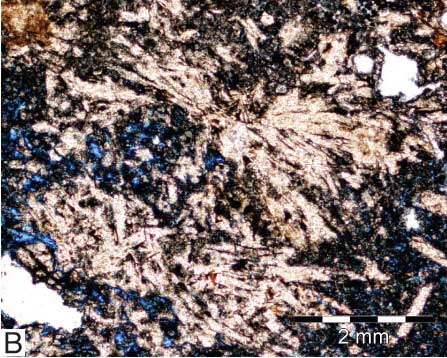
Figure 9--Silica-replaced evaporite textures. C) Silica-replaced evaporite crystal pseudomorphs in SWP Facies. Laths become "bent" and sub-parallel to the periphery of the nodule at the contact with the host sediment.
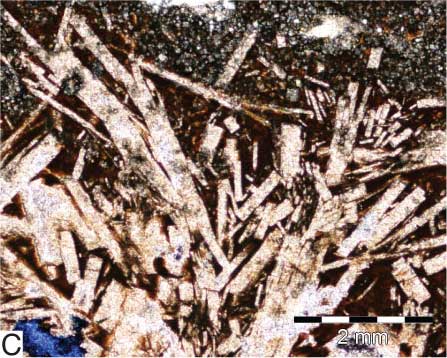
Figure 9--Silica-replaced evaporite textures. D) This sample shows original evaporite crystals replaced by clear to brown silica (E). This was followed by a dissolution/corrosion event (arrow). Remaining porosity was filled by clear megaquartz cement (Q).
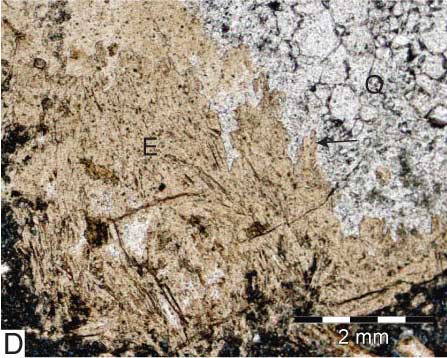
Figure 10--#2 Lyle Schaben "P" core photo and description from ∼4,418 ft to 4,431 ft. Note the SB1 surface at ∼4,424 ft that separates DS1 (below) from DS2 (above). Strata below SB1 contain abundant evidence for subaerial exposure, including iron-stained (F) mottled areas. Petrographic examination indicates some of these altered areas are characterized by a central area filled with coarsely crystalline calcite cement surrounded by a halo rich in hematite and fenestral pores in dolomitic and replacive poikilotopic calcite matrix (see fig. 12C), which may indicate these are associated with land plant roots. Vanstone (1991) described identical feature in late Osagean-early Meramecian paleosols from southwest Britain. Strata below SB1 are also affected by a coarsely crystalline calcite poikilotopic replacement and cement (see also figs. 3 and 12A). Strata above SB1 consist of MW and SWP facies, containing abundant silica-replaced evaporites (e.g. ECN = coalesced evaporite nodules).

Table 3--Evidence for early silicification, evaporates, dolomitization.
| 1) Close association of silicification and burrowing suggesting that burrows may act as a site for the initiation of the process. Lawrence (1993) noted that the same relationships have been made from DSDP sediments and indicated that higher organic content and a high porosity and permeability of burrow fill may predispose burrows to early chertification. |
| 2) Although minor grain interpenetrations and shell breakage occur, there is an overall lack of compaction evidence in EWPG facies prior to silicification. Meyers (1977) noted similar relationships in Mississippian chertified facies in New Mexico that he interpreted as indicating early chert. |
| 3) Very little original calcitic syntaxial or epitaxial cements have been identified in EWPG facies to date. Instead, isopachous chalcedony cement lines primary pores that contain later pore-filling silica cements. The lack of calcite cements in these facies, which typically are characterized by early calcite cements, and the presence of isopachous chalcedony cements in primary intergranular pores indicates early silicification. |
| 4) The loose packing of much of the relict sponge spicules and their molds suggests dissolution and reprecipitation of silica prior to deep burial. |
| 5) Evidence of early differential compaction characterized by brittle fracturing of silicified areas (including original evaporite minerals) and soft-sediment deformation of surrounding dolomite sediment. Fractures in silicified areas are commonly filled with dolomitic sediment. Meyers (1977; Mississippian strata) and Saller et al. (1991; Devonian strata) noted similar features that they used as lines of evidence for early silicification. |
| 6) Stylolites commonly occur within dolomite facies or at the contacts of carbonate sediment and silicified areas (but not within silicified areas) indicating greater compaction after silicification. |
|
7) Anhydrite in ancient evaporites is readily compacted (Maiklem et al., 1969; Shearman and Fuller, 1969). The preservation of radiating bladed evaporite crystal and nodule textures without much breakage or compaction is supportive of early evaporite emplacement and silica replacement prior to a heavy overburden. Similar preservation has been documented by Chowns and Elkins (1974) in Mississippian strata and Geeslin and Chafetz (1982) in Ordovician strata, which they interpreted to support early silicification. In addition, the preserved relict lath textures of many crystals and nodules in this study indicate they were originally made of anhydrite (Kinsman, 1970; Shearman, 1978). Geeslin and Chafetz (1982) recognized similar textures and interpreted them to indicate silicification during very early diagenesis while still in the vadose zone. This is because hydration of anhydrite to gypsum takes place readily in the presence of water (e.g. in a phreatic mixing zone; Shearman, 1978), and the silicified nodules lack any evidence of hydration of anhydrite to gypsum. The presence of bent and broken crystals and disruption of anhydrite crystals by displacive growth is remarkably similar to those shown by the Shearman and Fuller (1969) for Holocene anhydrite laths in halite-cemented nodules from the supratidal sediments of the Trucial Coast. Some of the evaporites show chicken-wire fabric and occur with fenestral fabric which also supports the analogy (fig. 9A). Rare nodule fabrics with elongate crystal psuedomorphs of original evaporites occur (fig. 8). These are similar to fabrics shown by Orti and Rosell (2000) from the Miocene of Spain. They interpret these morphologies as distinctive of the anhydrite-to-gypsum hydration process, in which anhydrite originally formed interstitially in the sediment in a playa/sabkha setting replacing or displacing the matrix. Other evidence supporting replacement of original evaporites includes the presence of length-slow chalcedony (quartzine and lutecite), which has been interpreted to be associated with the replacement of evaporites (Folk and Pittman, 1971). |
| 8) Some areas of silica-replaced evaporite pseudomorphs contain inclusions of dolomite crystals. This indicates a close temporal association of dolomite, evaporites, and silicification, all occurring early and perhaps simultaneously. |
| 9) Post-DS2 subaerial exposure, burial compaction, and structural uplift resulted in brittle fracturing and brecciation that crosscuts all DS2 and DS1 facies and previous diagenetic events, including silicified evaporites. Several generations of crosscutting fractures are filled with a variety of material including silica cement, calcite cement, shale, subangular-to-rounded silt- to coarse-grained-size detrital quartz, chert, megaquartz, chalcedony grains, carbonate micrite, and non-skeletal and skeletal grains. |
Prev Page--Geologic Setting || Next Page--Depositional Environments
Kansas Geological Survey
Web version July 10, 2006
http://www.kgs.ku.edu/Current/2006/franseen/04_facies.html
email:webadmin@kgs.ku.edu